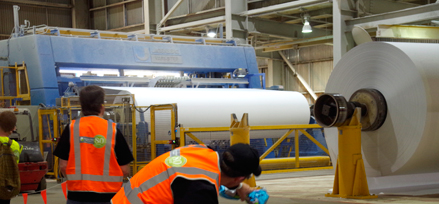Opal Australian Paper informed 35 of its workers just before Christmas that they were going to be stood down with full pay for an indefinite period of time. The stand downs were effective from 1 January 2023. Sources: News.com.au and Timberbiz
According to AAP, a further 120 workers are facing also being stood down later this month or early next month.
The stand downs had been looming for some time following a supreme court ruling and a timber shortage.
Opal reportedly employed 850 workers at its Maryvale mill, according to The Weekly Times, prior to the temporary stand downs, and is the Latrobe Valley’s biggest employer.
Australian Manufacturing Workers’ Union Assistant National Secretary (Printing) Lorraine Cassin was outraged at the job cuts as well as the late notice.
“It‘s unconscionable that Opal management have sacked 37 workers with only two days’ notice in the middle of the holiday season,” she told news.com.au
“This decision comes less than a month after Opal workers successfully defended their rights and protections through industrial action, after Opal management tried to cut wages and conditions.”
She slammed the company, pointing out it had “made a fortune” during the Covid-19 pandemic.
“It’s unbelievable that they’d turn around now and treat their workers like this,” Ms Cassin said.
“Opal must work with unions and the state government to make sure these workers have the support they need.”
In early November, government-owned timber business VicForests lost a Supreme Court case which found it was not doing enough to protect endangered wildlife including two possum species.
As a result, the company was ordered to scale back its timber harvesting in parts of rural Victoria.
VicForests was a massive supplier for Opal Australian Paper and they have been unable to obtain the necessary materials since for paper to be created.
After the court order, the paper producer flagged that stand downs was a very real possibility.
“Unfortunately, limited stand-downs may become necessary, and we are currently consulting on this issue with our team members,” Opal Australian Paper said in a statement 10 days after the court decision.
“Our priority is to continue to keep our team members fully updated on the situation as it develops further.
“As a large Latrobe Valley employer, secure, certified wood supply is crucial to Opal Australian Paper’s Maryvale operations.”
Opal Australian Paper ran out of materials to make white sheets of paper On 23 December 2022.
It hasn’t resumed operations since and production remains on hold indefinitely.
VicForests has appealed the Supreme Court decision.
In a statement to news.com.au, Opal said: “To date we have been unable to identify viable alternative sources of wood and as a result, white paper production on the M5 machine at Maryvale was impacted from 23 December.
“This equipment stoppage has led to direct production workers engaged on M5 to be stood down on a temporary basis from the first of January 2023…
“This is a complex situation and no longer-term decisions on operational changes have been made at this stage.”
A worker at the mill, Justin Flenley, has spoken out in the wake of the temporary job losses.
“I don‘t want a redundancy or government subsidy, I want just want to keep my job,” Mr Flenley told the ABC.
Meanwhile Opal has successfully applied to the EPA Victoria for temporary relief on certain elements of its operating licence for 120 days.
This temporary license application relates specifically to short term changes and no longer-term decisions on operational changes at the Mill have been made at this stage.
The specific temporary licence discharge limit amendments are:
- Recovery Boiler R6 air emissions of sulfur dioxide (SO2) maximum increased from 2500 grams per minute to 5000 g/min during periods when Recovery Boiler R5 is offline (R5 licence limit is 2920 g/min) and an increase in 90th percentile limits from 500 g/min to 1500g/min.
- Recovery Boiler R5 air emissions of sulfur dioxide (SO2) maximum increased from 2920 g/min to 5000 g/min during periods when Recovery Boiler R6 is offline (R6 licence limit is 2500 g/min) and an increase in 90th percentile limits from 1000 g/min to 1500g/min.
- Waste Water Treatment Plant Discharge to River Biochemical Oxygen Demand (BOD) maximum increased from 30 milligrams/litre to 45 mg/L.
- Waste Water Treatment Plant Discharge to River Ammonia maximum increased from 3.1 mg/L to 4.5 mg/L.
- Waste Water Treatment Plant Discharge to River Colour maximum increased from 200 PCU to 250PCU.
All other discharge emissions licence limits remain unchanged.
Opal will be undertaking additional monitoring of the temporary discharge emissions during this period.







